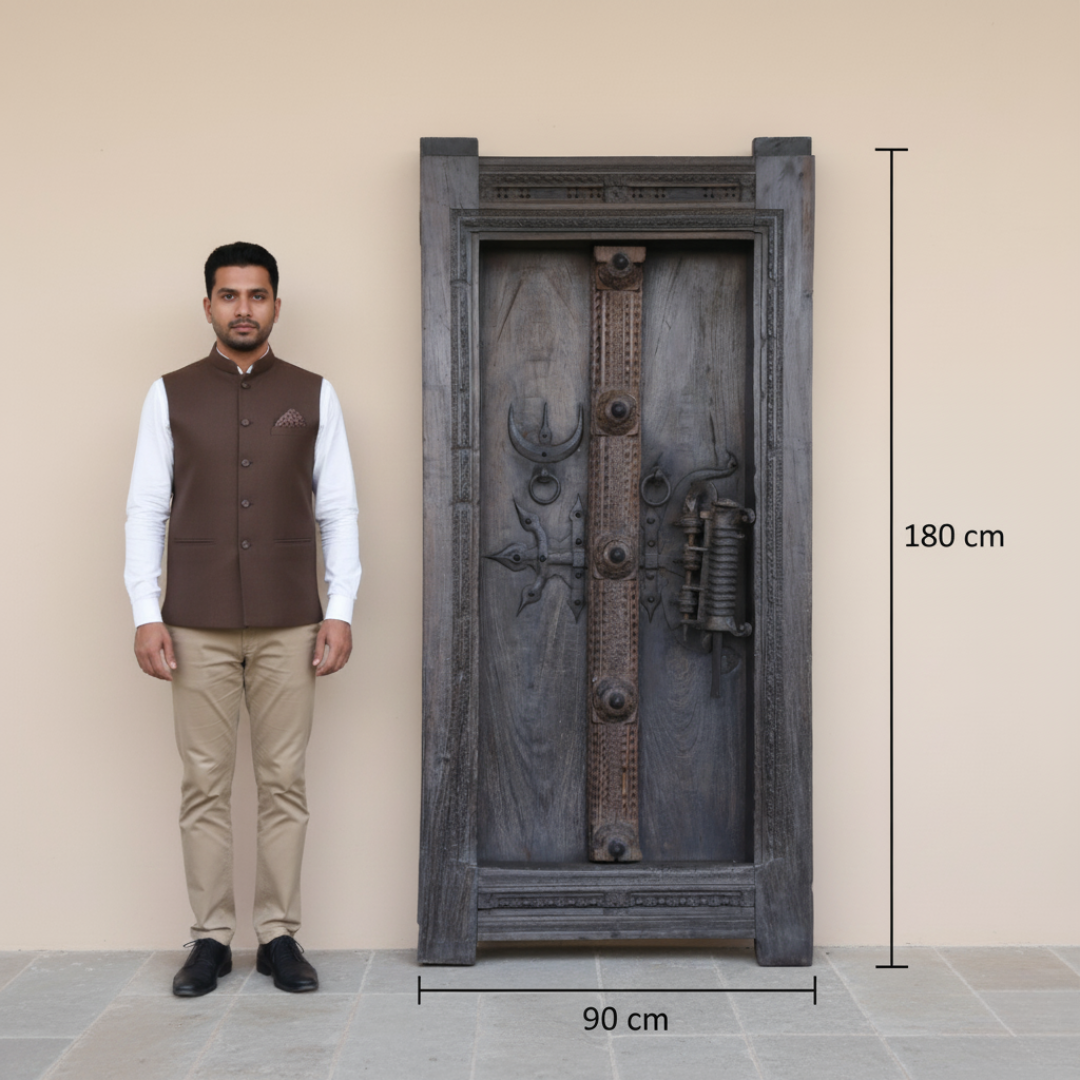
Price
Materials
Period
Place of origin
SKU
Dimensions
Available Stock: 1
About the product
17th-Century South Indian Temple Door with Frame
Original Manichitrathazhu Lock | Solid Sheesham Wood | Sacred Architectural Salvage from Kerala or Tamil Nadu
✦ A Portal to South India’s Sacred Past
This rare 17th-century temple or ancestral home door is an authentic piece of India’s spiritual and architectural history. Handcrafted from dense Sheesham wood (Indian Rosewood) and fitted with its original Manichitrathazhu lock, this masterpiece embodies the technical ingenuity, symbolism and artistry of Dravidian design.
Once part of a Nalukettu courtyard home or temple sanctum, the door marked the threshold between material and divine realms, acting as both protector and ceremonial gateway. Its survival in such intact condition makes it a museum-quality artefact suitable for collectors, curators, and heritage-led interior projects.
✦ Architectural Significance & Symbolism
The centrepiece is the Manichitrathazhu lock, a rare spring-bolt mechanism still intact. In South Indian tradition, this lock was more than functional, it was a spiritual safeguard, believed to protect homes and temples from misfortune as well as intrusion.
The door is richly detailed with:
• Floral lattice carvings and vertical mullions that reflect Dravidian symmetry
• Original iron studs, crescent motifs and latchwork forged entirely by hand
• Deeply carved frame and lower fretwork, demonstrating 17th-century artisan skill
• Charcoal-toned natural patina, built through centuries of tropical climate exposure
Unlike later colonial adaptations, this door retains a purely Dravidian vocabulary of balance, protection, and sacred proportion.
✦ Key Features
Date: Circa 1600s
Region: South India
Material: Solid Sheesham wood (Indian Rosewood)
Locking System: Fully original Manichitrathazhu mechanism, spring-bolt style
Ironwork: Original hand-forged studs, handles, and locking elements
Finish: Aged patina in hues of brown, grey, and deep rosewood black
Condition: Structurally sound with authentic wear
✦ Dimensions & Weight
Height: 192 cm
Width: 102 cm (with frame)
Depth: 18 cm
Weight: Approx. 112 kg
✦ Cultural & Spiritual Context
In South Indian architectural philosophy, doors were more than utilitarian—they were sacred guardians. Commissioned by high-ranking families and temple authorities, such doors embodied wealth, devotion, and protection.
The Manichitrathazhu lock, celebrated in Malayalam folklore and temple epics, was an emblem of prestige and spiritual fortification. Surviving examples of this complexity are extremely rare, elevating this piece from decorative salvage to a true cultural heirloom.
✦ Styling Inspiration
Interiors: Use as a dramatic wall-mounted panel, gallery focal point, or functional statement door.
Hospitality: Install in boutique hotels, heritage villas, or yoga retreats to add authenticity and gravitas.
Spiritual Settings: Place in meditation rooms, sanctuaries, or garden courtyards as a symbolic passage between realms.
Pair with lime-plastered walls, sandstone flooring, or minimalist backdrops to highlight its sculptural form.
✦ Why This Piece Stands Out
✔ One of the few surviving doors with a fully intact Manichitrathazhu mechanism
✔ Rooted in 17th-century Dravidian philosophy and temple heritage
✔ Carved entirely by hand, with no modern restoration
✔ Museum-grade and installation-ready
✔ Ideal for collectors, architects, designers, and cultural institutions
✦ Delivery & Installation
Due to its weight and significance, this piece qualifies for white-glove delivery within the UK. Local pickup and international shipping can be arranged on request. Regen Bespoke offers bespoke delivery advice for architectural antiques of this scale.
Exclusively at Regen Bespoke
Preserving the sacred geometry, heritage mechanics, and ancestral devotion of India’s architectural soul.






